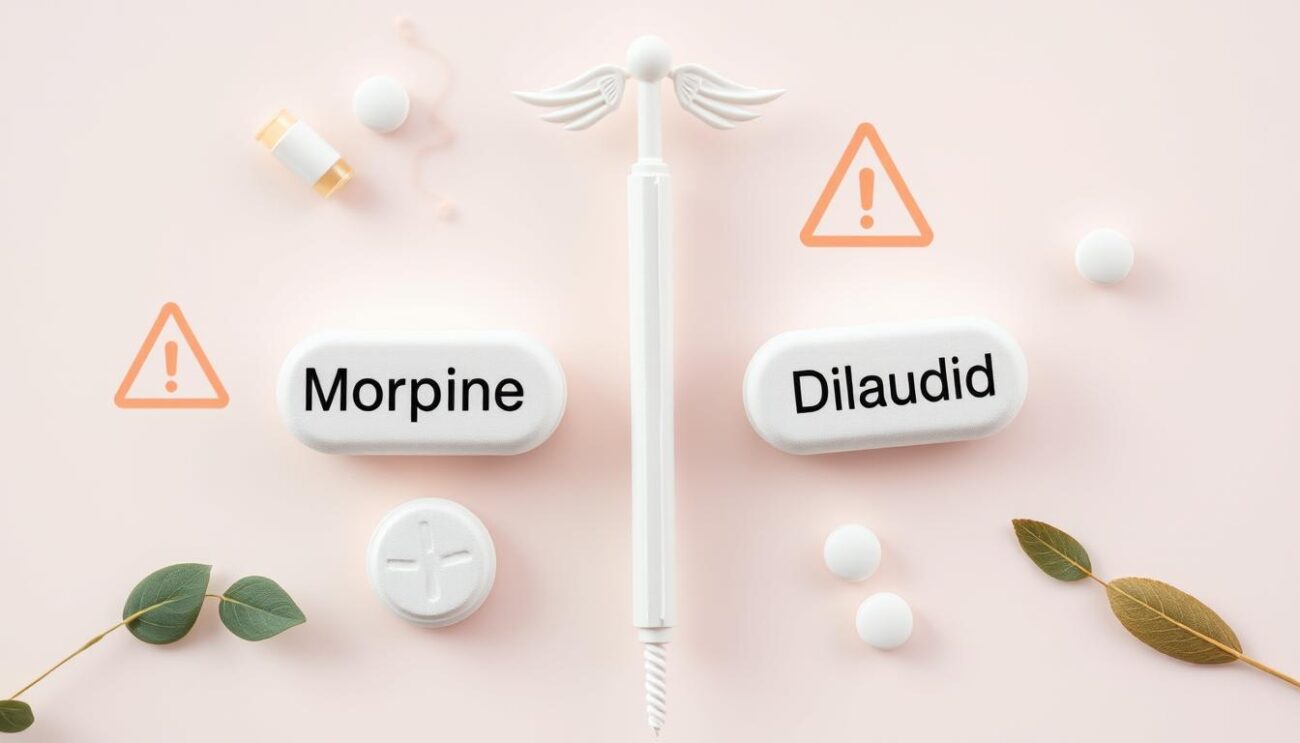When it comes to managing severe pain, healthcare providers often face a critical decision – should they prescribe morphine or the more potent opioid, Dilaudid (hydromorphone)? This comparison delves into the intricacies of these two powerful analgesics, exploring their relative potency, onset and duration of effects, as well as their impact on patient outcomes. The question is, which one offers superior pain relief while minimizing the risks associated with opioid therapy?
Key Takeaways
- Hydromorphone (Dilaudid) was found to provide significantly better pain relief compared to morphine in multiple studies.
- Hydromorphone has a higher potency, with a small but significant effect size in pain reduction over morphine.
- Hydromorphone showed a clear advantage over morphine in the treatment of acute pain, but not for chronic cancer pain.
- Side effect profiles were similar between the two opioids, suggesting comparable safety concerns.
- Careful dosage considerations and monitoring are crucial when prescribing these potent pain medications.
Understanding Opioids: Morphine and Dilaudid
Defining Opioids and Their Role in Pain Management
Opioids are a class of powerful medications derived from the poppy plant or synthetically created to mimic their effects. These opioid analgesics work by interacting with opioid receptors in the central and peripheral nervous systems, reducing the transmission of pain relief medications to the brain. Morphine and hydromorphone (Dilaudid) are two commonly used opioid classification medications for managing moderate to severe acute and chronic pain.
Exploring the Origins and Classifications of Morphine and Dilaudid
Morphine is a naturally occurring opioid analgesic found in the opium poppy plant, while hydromorphone (Dilaudid) is a semi-synthetic derivative of morphine. Both drugs are classified as Schedule II controlled substances by the Drug Enforcement Administration (DEA), indicating a high potential for abuse and addiction, but also recognized medical uses. The DEA considers hydromorphone to be two to eight times more potent than morphine, with a shorter duration of action and greater sedative effects.
| Medication | Equi-Analgesic Dose | Duration of Action |
|---|---|---|
| Morphine (IV/SC) | 10 mg | 3-4 hours |
| Morphine (Oral) | 30 mg | 3-4 hours |
| Hydromorphone (Dilaudid, Parenteral) | 1.5 mg | 2-3 hours |
| Hydromorphone (Dilaudid, Oral) | 7.5 mg | 2-3 hours |
Anesthesia and Analgesia research conducted in 2006 showed that hydromorphone, when used as an alternative to morphine in acute pain, demonstrated safety and efficacy in a randomized clinical trial, indicating its potential as a viable analgesic option.
Comparative Analysis: Potency and Duration
When exploring the potency and analgesic properties of opioid medications, the relationship between hydromorphone (Dilaudid) and morphine is a crucial consideration. According to the Drug Enforcement Administration, hydromorphone is approximately two to eight times more potent than morphine. This suggests that smaller doses of hydromorphone may be required to achieve similar pain relief efficacy as higher doses of morphine.
However, it’s important to note that the duration of action for morphine is generally longer than that of hydromorphone. Hydromorphone has a shorter half-life and a more rapid onset of effects, which can impact dosing strategies and the overall management of pain. The relative potency and pharmacokinetic differences between these opioid analgesics can play a significant role in determining the most suitable treatment approach for patients.
Assessing the Relative Potency: Hydromorphone vs. Morphine
Recent studies have provided valuable insights into the comparative potency and analgesic properties of hydromorphone and morphine. In a single-center, double-blinded, randomized trial involving 138 parturients undergoing scheduled cesarean delivery, researchers found no significant difference in pain scores with movement at 24 hours between intrathecal hydromorphone (median 4) and intrathecal morphine (median 3).
Additionally, the study reported that the opioid consumption in the first 24 hours was higher in the intrathecal hydromorphone group (median oral morphine milligram equivalents 30) compared to the intrathecal morphine group (median 22.5). Interestingly, the median time to first opioid request was shorter for hydromorphone (5.4 hours) compared to morphine (12.1 hours), suggesting a shorter duration of action for hydromorphone.
Contrary to the commonly used equipotency ratio of 1:5 for hydromorphone to morphine, a historical cohort study involving 605 adult patients undergoing elective, non-cardiac surgery reported a ratio closer to 1:6.5, indicating a slightly lower potency difference between the two opioids.
Overall, these findings suggest that while hydromorphone may be more potent than morphine, the differences in pain relief efficacy and opioid consumption are not necessarily significant, and the clinical implications may depend on the specific patient population and treatment context.
morphine vs dilaudid
When it comes to the management of pain, the choice between morphine and hydromorphone (Dilaudid) can significantly impact the onset and duration of analgesic effects. Understanding these pharmacokinetic differences is crucial for healthcare providers to optimize pain relief and tailor treatment plans to individual patient needs.
Rapid Onset with Dilaudid
Hydromorphone, the active ingredient in Dilaudid, is known to have a more rapid onset of action compared to morphine. This means that Dilaudid can provide quicker pain relief, often within 15-30 minutes of administration, making it a suitable option for managing acute or breakthrough pain.
Longer-Lasting Effects of Morphine
In contrast, the analgesic effects of morphine tend to last longer, typically for 4 to 6 hours. This extended duration of action can be advantageous in the management of chronic pain conditions, where sustained pain relief is essential for improving patient quality of life.
The differences in onset and duration between morphine and hydromorphone can influence the choice of medication and dosing regimen, particularly in the management of acute versus chronic pain conditions.
| Medication | Onset of Action | Duration of Effects |
|---|---|---|
| Morphine | 30-60 minutes | 4-6 hours |
| Hydromorphone (Dilaudid) | 15-30 minutes | 2-4 hours |
These pharmacokinetic differences highlight the importance of carefully considering the patient’s specific needs and the desired onset and duration of pain relief when selecting between morphine and Dilaudid as part of a comprehensive pain management strategy.
Clinical Efficacy: Analgesic Properties
Both morphine and hydromorphone (Dilaudid) have demonstrated clinical efficacy in the management of acute and chronic pain conditions. A meta-analysis published in the British Journal of Anaesthesia found that hydromorphone may provide slightly better pain relief compared to morphine, particularly for acute pain. However, the authors noted that the limited number and size of the trials, as well as the heterogeneity of the results, warranted further research to confirm this finding.
In a randomized clinical trial, hydromorphone demonstrated safety and efficacy as an analgesic alternative to morphine in acute pain management. Additionally, a meta-analysis of the clinical effects of hydromorphone and morphine revealed comparable efficacy between the two drugs.
Evaluating Pain Relief Capabilities in Acute and Chronic Conditions
Clinicians must consider the individual patient’s needs, pain severity, and response when selecting between morphine and hydromorphone for optimal pain management. While hydromorphone may offer a slight advantage for acute pain, the overall analgesic efficacy of the two opioids appears to be similar, particularly in the management of chronic pain conditions.
“Further studies would be required to confirm the slight advantage of hydromorphone over morphine due to the limited number and size of trials.”
The available research suggests that hydromorphone may have more potent neuro-excitant effects than morphine due to its metabolite hydromorphone-3-glucuronide. However, the clinical significance of this finding is still under investigation. Clinicians must carefully weigh the potential benefits and risks of both morphine and hydromorphone when managing acute and chronic pain.
Side Effect Profiles: Understanding the Risks
When it comes to pain relief, both morphine and hydromorphone (Dilaudid) carry a risk of significant side effects. These opioid adverse reactions can include respiratory depression, sedation, constipation, and the potential for addiction and dependence. While the side effect profiles of these two powerful pain medications are generally similar, hydromorphone may be slightly more sedating than morphine.
To minimize the risks associated with these opioids, careful monitoring and titration of dosages are essential. Patients and healthcare providers must carefully weigh the benefits of effective pain relief against the potential for adverse events and develop appropriate risk mitigation strategies. Vigilance and proactive management are crucial to ensure patient safety when using these medications.
| Side Effect | Morphine | Hydromorphone (Dilaudid) |
|---|---|---|
| Respiratory Depression | ✓ | ✓ |
| Sedation | ✓ | ✓✓ |
| Constipation | ✓ | ✓ |
| Addiction and Dependence | ✓ | ✓ |
It is crucial to understand the side effect profiles of these opioids and take appropriate measures to mitigate the risks. Patients and healthcare providers must work together to ensure the safe and effective use of these medications for pain management.
“Careful monitoring and titration of dosages are essential to minimize the risks associated with these powerful pain medications.”
Dosage and Administration: Balancing Efficacy and Safety
The dosage and administration of morphine and hydromorphone (Dilaudid) require careful consideration to achieve the optimal balance between analgesic efficacy and patient safety. Due to hydromorphone’s greater potency, lower doses are typically required compared to morphine to attain the desired pain relief.
Exploring Optimal Dosing Strategies and Routes of Administration
Both morphine and hydromorphone can be administered orally, intravenously, or subcutaneously, with the route of administration influencing the onset and duration of effects. Healthcare providers must follow evidence-based pain medication guidelines and closely monitor patients to determine the optimal dosing strategy and administration route for each individual’s needs, taking into account factors such as pain severity, patient response, and risk of adverse events.
Effective patient-centered care involves carefully titrating the morphine dosing or hydromorphone dosing to provide adequate pain relief while minimizing the potential for opioid administration routes that could lead to adverse outcomes. This requires a thorough understanding of the unique pharmacokinetic and pharmacodynamic properties of these opioid analgesics.
“Opioid prescriptions per capita increased by 7.3% from 2007 to 2012, with higher increases observed in family practice, general practice, and internal medicine compared to other specialties.”
The careful management of opioid administration routes and dosing strategies is crucial in ensuring the safe and effective use of these pain medications, ultimately prioritizing the well-being and safety of patients.
Patient-Controlled Analgesia (PCA): A Comparative Study
When it comes to managing pain, patient-controlled analgesia (PCA) has become a widely adopted approach. This technique allows patients to self-administer predetermined doses of medications, such as morphine PCA or hydromorphone PCA, to alleviate acute, chronic, postoperative, or labor-related pain.
Assessing Cognitive Function, Mood, and Side Effects in PCA Use
A study published in Anesthesia & Analgesia compared the use of morphine and hydromorphone in patient-controlled analgesia (PCA) systems. The researchers found that both medications provided adequate pain relief, with no significant differences in side effects. However, patients receiving hydromorphone exhibited poorer cognitive performance on cognitive function tests, while reporting better mood and less anger/hostility compared to the morphine group.
These findings suggest that the choice between morphine PCA and hydromorphone PCA for PCA may depend on the individual patient’s needs, with morphine potentially offering advantages in preserving cognitive function and hydromorphone potentially providing mood-enhancing benefits.
“The anger scores in the group H at 48 h and 96 h after surgery were significantly lower compared to group S (P = 0.012 and 0.005).”
The study also highlighted the importance of closely monitoring opioid cognitive effects and opioid mood effects when utilizing patient-controlled analgesia (PCA) for pain management. Clinicians must carefully weigh the potential benefits and risks associated with each opioid medication to ensure the optimal treatment plan for their patients.
Drug Interactions and Precautions
Both morphine and hydromorphone (Dilaudid) can interact with a variety of other medications, drugs, and herbal supplements, potentially resulting in dangerous side effects. Healthcare providers must carefully review a patient’s complete medication list, including any over-the-counter medications, illicit substances, or herbal supplements, to identify potential opioid precautions and medication safety concerns.
Particular caution is warranted when prescribing opioids to patients with a history of substance abuse considerations or certain medical conditions, such as respiratory or renal impairment. Ongoing monitoring and patient education are essential to ensure the safe and appropriate use of these powerful pain relievers.
Identifying Potential Interactions and Contraindications
Some key considerations regarding morphine drug interactions and hydromorphone drug interactions include:
- Alcohol, other opioids, and central nervous system depressants can potentiate the respiratory depressant effects of hydromorphone, increasing the risk of respiratory depression that might result in death.
- Exposure to hydromorphone may be significantly increased in patients with moderate hepatic impairment or impaired renal function, requiring dose adjustments.
- Elderly patients may be more sensitive to the effects of hydromorphone and are more likely to have age-related lung, liver, kidney, or heart problems.
- Patients with allergies, acute or severe asthma, severe lung or breathing problems, stomach or bowel blockage, hypotension, pancreatitis, or seizures should not use these opioid medications.
| Medication Interaction | Potential Risks | Recommendation |
|---|---|---|
| Alcohol, other opioids, CNS depressants | Increased respiratory depression, risk of death | Avoid concomitant use |
| Hepatic or renal impairment | Increased hydromorphone exposure | Dose adjustments required |
| Elderly patients | Increased sensitivity to effects | Use with caution, monitor closely |
| Allergies, severe asthma, GI/respiratory conditions | Risk of adverse events | Contraindicated |
By carefully evaluating potential drug interactions and contraindications, healthcare providers can help ensure the safe and effective use of morphine, hydromorphone, and other opioid analgesics for pain management.

Conclusion
In conclusion, morphine and hydromorphone (Dilaudid) are both potent opioid analgesics widely used to manage moderate to severe pain. While they share similarities in their mechanisms of action and overall therapeutic effects, there are notable differences in their potency, onset and duration of effects, and associated risks. Healthcare providers must carefully consider these factors, as well as individual patient needs and preferences, when selecting the appropriate opioid analgesic for pain management.
Ongoing monitoring, patient education, and a comprehensive approach to pain relief that balances efficacy and safety are essential to ensure optimal outcomes and minimize the potential for adverse events or misuse. By understanding the nuances between morphine and hydromorphone, clinicians can make more informed decisions and provide patient-centered pain management tailored to the unique needs and characteristics of each individual.
While further research is warranted to fully elucidate the comparative safety and efficacy of these opioid analgesics, the available evidence suggests that both morphine and hydromorphone have an important role to play in the management of moderate to severe pain when utilized judiciously and with appropriate clinical oversight.






